1.7 Select a Channel of Communication
[Author removed at request of original publisher] and Linda Macdonald
Learning Objective
- Select the most appropriate channel and form for your message based on the purpose and audience.
- Define media richness
- Review individual rights to privacy in workplace communications
Purpose is closely associated with channel. Given the purpose and the audience, you will then select the best channel of communication.
Is a text message sufficient to deliver your message? When is it appropriate to send an instant message (IM) or text message? Or is a conventional e-mail or fax appropriate? So that readers can maintain file records, is a report attached to an email more desirable? Is the message too sensitive or complex and require in-person delivery? Do you need to address questions quickly?
Your decision should consider the audience’s preferences, the organization’s needs, the complexity of the message, and the need for “media richness”.
Features of Various Channels
Each channel has features that make it appropriate or inappropriate in certain situations. Each has its own strengths, weaknesses, and understood expectations as summarized below.
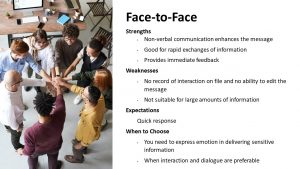
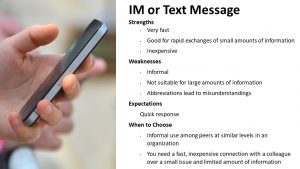
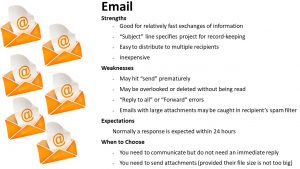
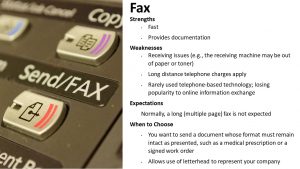
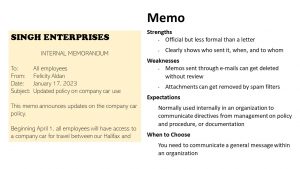
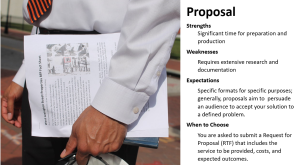
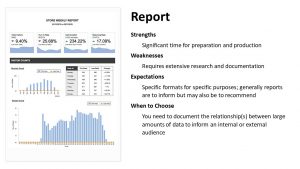
Check Your Knowledge (10 Questions)
Media Richness
By choosing the correct channel for a message, you can increase the likelihood that your message will be understood and acted upon in the manner you intended.
Your decision should consider the audience’s preferences, the organization’s needs, the complexity of the message, and the need for “media richness”. A phone call has less media richness than a Microsoft Teams or Zoom video call. The Zoom video call adds visual elements to the call that enhance the message; however, a video call usually lacks a full view of the speaker and all their non-verbal communications, and speakers often look at the listener’s image rather than the camera when they speak. A face-to-face meeting has greater media richness than a video call.
Four qualities determine a medium’s richness:
- Multiple information cues simultaneously: The richer the medium, the more cues. The addition of body language to speech adds cues.
- Speed of feedback: Richer media have faster response times. Feedback is immediate in a verbal exchange but delayed or non-existent through the medium of a poster.
- Personal focus: A letter addressed to a single recipient has more personal focus than a poster visible to many.
- Ability to use natural language. A face-to-face medium provides an opportunity to use more natural language because body language supplements the oral communication, the speaker can tell more easily when additional explanations are necessary, and the speaker is able to adjust the formality of the language for the context.
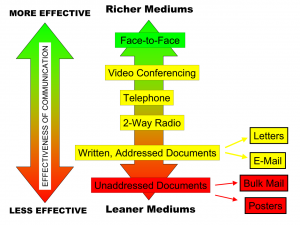
Not all content should be delivered through a rich medium. Simple, routine messages only require a lean medium. A leaner medium is often the most efficient way to deliver content in business when the purpose is simply to inform the audience.
Check Your Knowledge
Privacy and Security of Electronic Communications
An employer has the right to view your electronic files stored on their network, to track you when using their equipment, and to view your company-provided social media or your personal but public posts. When you call and leave a voice message for a friend or colleague at work, do you know where your message is stored? Any time you send an IM, text, or e-mail or leave a voice message, your message is stored on more than one server, and it can be intercepted or forwarded to persons other than the intended receiver. Are you ready for your message to be broadcast to the world? Do your words represent you and your business in a positive light?
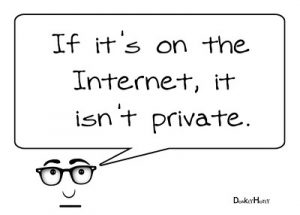 Newsweek columnist Jennifer Ordoñez writes that it has become routine for employees to sign a consent form “attesting that you understand and accept that any e-mails you write, Internet sites you visit or business you conduct on your employer’s computer network are subject to inspection” (Ordoñez, 2008, para. 1). As you use Instagram, update your Facebook page, check LinkedIn, reply through Twitter, or send a text, you leave an electronic trail of “bread crumbs” that merge personal and professional spheres, opening up significant issues of privacy. Anything you write or record in the workplace can be stored for later retrieval by people for whom your message was not initially intended.
Newsweek columnist Jennifer Ordoñez writes that it has become routine for employees to sign a consent form “attesting that you understand and accept that any e-mails you write, Internet sites you visit or business you conduct on your employer’s computer network are subject to inspection” (Ordoñez, 2008, para. 1). As you use Instagram, update your Facebook page, check LinkedIn, reply through Twitter, or send a text, you leave an electronic trail of “bread crumbs” that merge personal and professional spheres, opening up significant issues of privacy. Anything you write or record in the workplace can be stored for later retrieval by people for whom your message was not initially intended.
Review any electronic communication before you send it. Spelling and grammatical errors will negatively impact your credibility. With written documents we often take time and care to get it right the first time, but the speed of IM, text, or e-mail often leads to bypassing this important review cycle of written works. Just because the message you prepare in IM is only one sentence long, doesn’t mean it can’t be misunderstood or expose you to liability. Take time when preparing your written messages, and review your work before you click “send.”
Check Your Knowledge (3 Questions)
Review: Context, Purpose, Audience, and Channel (5 Questions)
The following resource is adapted from Melissa Ashman and licensed with a Creative Commons – Attribution 4.0 International License.
References
Ordoñez, J. (2008, July 14). The technologist: They can’t hide their pryin’ eyes. Retrieved from http://www.newsweek.com/id/143737.
Photos:
“Photo of people holding each other’s hands” by faxels from Pexels
“Texting Congress 1” by afagen is licensed under CC BY-NC-SA 2.0.“Email” by Javier Domínguez Ferreiro is licensed under CC BY-SA 2.0“74/465+1 Send/Fax” by DaveCrosby is licensed under CC BY-SA 2.0.
“Business letters” by 7102sew is licensed under CC BY-SA 2.0.
“Store Weekly Report” by joeyedeason1 is licensed under CC BY-SA 2.0.
“If it’s on the Internet, it isn’t private.” by DonkeyHotey is licensed under CC BY 2.0.
Diagram: Media Richness Theory Diagram PNG by Tntdj licensed under CC 3.0

